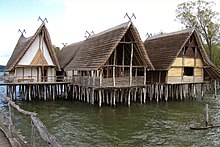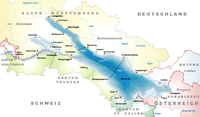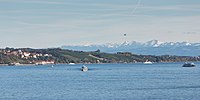
A crannog is typically a partially or entirely artificial island, usually built in lakes and estuarine waters of Scotland, Wales, and Ireland. Unlike the prehistoric pile dwellings around the Alps, which were built on the shores and not inundated until later, crannogs were built in the water, thus forming artificial islands.

The Neolithic or New Stone Age is an archaeological period, the final division of the Stone Age in Europe, Asia and Africa. It saw the Neolithic Revolution, a wide-ranging set of developments that appear to have arisen independently in several parts of the world. This "Neolithic package" included the introduction of farming, domestication of animals, and change from a hunter-gatherer lifestyle to one of settlement. The term 'Neolithic' was coined by Sir John Lubbock in 1865 as a refinement of the three-age system.

Neolithic architecture refers to structures encompassing housing and shelter from approximately 10,000 to 2,000 BC, the Neolithic period. In southwest Asia, Neolithic cultures appear soon after 10,000 BC, initially in the Levant and from there into the east and west. Early Neolithic structures and buildings can be found in southeast Anatolia, Syria, and Iraq by 8,000 BC with agriculture societies first appearing in southeast Europe by 6,500 BC, and central Europe by ca. 5,500 BC (of which the earliest cultural complexes include the Starčevo-Koros, Linearbandkeramic, and Vinča.

Unteruhldingen is a small village, part of the town of Uhldingen-Mühlhofen, on the northwestern shore of Lake Constance, Germany. It is home to the Pfahlbauten, an open-air museum displaying reconstructions of Neolithic and Bronze Age pile dwellings. The buildings are idealized reconstructions from between the 1922 and 1941, which were designed based on archeological digs of the Wasserburg Buchau at Federsee. After 1945 the museum was led by the controversial but knowledgeable archeologist Hans Reinerth, one of the leading Nazi archaeologists of Amt Rosenberg. This museum has been expanded since to incorporate modern research.

Manerba del Garda is a town and comune in the province of Brescia, in Lombardy. It is located at the southwest side of the Lake Garda.

Butser Ancient Farm is an archaeological open-air museum and experimental archaeology site located near Petersfield in Hampshire, southern England. Butser features experimental reconstructions of prehistoric, Romano-British and Anglo-Saxon buildings. Examples of Neolithic dwellings, Iron Age roundhouses, a Romano-British villa and an early Saxon house are on display. The site is used as both a tourist attraction and a site for the undertaking of experimental archaeology. In this latter capacity, it was designed so that archaeologists could learn more about the agricultural and domestic economy in Britain during the millennium that lasted from circa 400 BCE to 400 CE, in what was the Late British Iron Age and Romano-British periods.
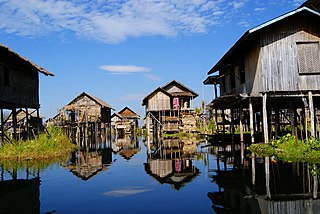
Stilt houses are houses raised on stilts over the surface of the soil or a body of water. Stilt houses are built primarily as a protection against flooding; they also keep out vermin. The shady space under the house can be used for work or storage. Stilt houses are commonly found in Southeast Asia, Oceania, Central America, Caribbean, northern parts of South America, Madagascar, Mauritius, Seychelles and the Maldives.

The Nordic Stone Age refers to the Stone Age of Scandinavia. During the Weichselian glaciation, almost all of Scandinavia was buried beneath a thick permanent ice cover, thus, the Stone Age came rather late to this region. As the climate slowly warmed up by the end of the ice age, nomadic hunters from central Europe sporadically visited the region. However, it was not until around 12,000 BCE that permanent, but nomadic, habitation in the region took root.

Uhldingen-Mühlhofen is a town at the northern shore of Lake Constance, Germany between Überlingen and Meersburg. The town is a popular holiday destination and home to the Pfahlbauten open-air museum in Unteruhldingen and the Birnau basilica.
Lüscherz is a municipality in the Seeland administrative district in the canton of Bern in Switzerland.
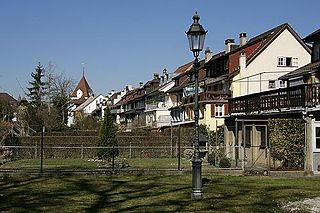
Sursee is a municipality in the district of Sursee in the canton of Lucerne, Switzerland. Sursee is located at the northern end of Lake Sempach, not far from where the Sure stream exits the lake ("See"), hence the name "Sursee".

Gaienhofen is a municipality in the district of Konstanz in Baden-Württemberg in Germany. It is located at the border with Switzerland.

Neolithic Greece is an archaeological term used to refer to the Neolithic phase of Greek history beginning with the spread of farming to Greece in 7000–6500 BC, and ending around 3200 BC. During this period, many developments occurred such as the establishment and expansion of a mixed farming and stock-rearing economy, architectural innovations, as well as elaborate art and tool manufacturing. Neolithic Greece is part of the Prehistory of Southeastern Europe.

Werd Island is the main island of the small island group Werd Islands in the westernmost part of the Lower Lake of Lake Constance just before the High Rhine leaves the part of the lake known as Rheinsee. It is located on Swiss territory between Stein am Rhein and Eschenz.

Prehistoric pile dwellings around the Alps are a series of prehistoric pile dwelling settlements in and around the Alps built from about 5000 to 500 BC on the edges of lakes, rivers or wetlands. In 2011, 111 sites located variously in Switzerland (56), Italy (19), Germany (18), France (11), Austria (5) and Slovenia (2) were added to the UNESCO World Heritage Site list. In Slovenia, these were the first World Heritage Sites to be listed for their cultural value.

Gunter Schöbel is a German archaeologist and director of the Pfahlbau Museum Unteruhldingen.

Kleiner Hafner is one of the 111 serial sites of the UNESCO World Heritage Site Prehistoric pile dwellings around the Alps, of which are 56 located in Switzerland.
Wauwilermoos or Egolzwil 3 is one of the 111 serial sites of the UNESCO World Heritage Site Prehistoric pile dwellings around the Alps, of which are 56 located in Switzerland.

La Grande Béroche is a municipality in the canton of Neuchâtel in Switzerland. On 1 January 2018 the former municipalities of Bevaix, Fresens, Gorgier, Montalchez, Saint-Aubin-Sauges and Vaumarcus merged to form the new municipality.
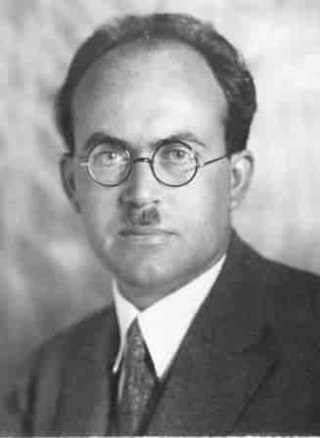
Hans Reinerth was a German archaeologist. He was a pioneer of Palynology and modern settlement archaeology, but is controversial because of his role before and during the period of National Socialism.





